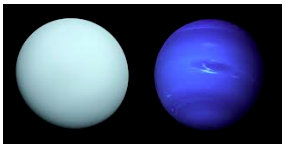
Dr Adam Masters is a space and planetary scientist with the Space and Atmospheric Physics Group at Imperial College, London. His research programme focuses on explaining how energy flows through the solar system via magnetic fields and charged particles and is underpinned by his involvement in spacecraft missions. Most recently he has worked on the Jupiter Icy Moons Explorer mission and the ongoing planning of future missions to Uranus and Neptune.
Adam introduced his talk with an overview of how the solar system formed and then gave a brief history of past missions to the planets such as the Cassini-Huygens mission to Saturn and Titan that ended in 2017 and the robotic rover missions to Mars. He also referred to the earlier Voyager missions with Voyager 2 making the closest ever approach to Uranus in January 1986 having been launched in the late 1970s.

The talk then focused on the ‘Ice Giants’ Uranus and Neptune which are at distances of 19 and 30 AU respectively from the Sun. They are called Ice Giants as most of the planets’ mass is made up of a dense fluid of icy materials – water, methane and ammonia which lies above a small rocky core. (Uranus is on the left.)
Adam advised that a science definition team for the Uranus mission was set up by NASA (JPL) and aims to glean the same level of information that the Galileo mission to Jupiter achieved. The conclusions of the Uranus mission study is that there should be an orbiter and atmospheric probe similar to the Galileo mission. Adam went on to discuss the following major themes of the Uranus system science that the team plans to investigate: the atmosphere, magnetic fields, ring system and moons (the largest being similar in size to Mercury).
Adam explained that Uranus has extreme seasons as its rotation axis is on its side which means that during its 80 years orbit around the Sun the Northern Hemisphere has 40 years of sunlight and 40 years of darkness.
Planning is now underway for a system launch of the Uranus mission in the 2030s with arrival of the orbiter spacecraft in the 2040s. Adam concluded by saying ‘We have a long way to go.’

